By Eric Vandenbroeck
Revisiting Myanmar
Resistance groups in
Myanmar try to take control of Yangon, Myanmar's biggest city and his former
home. To date however the military retains the majority of major urban areas -
home to crucial infrastructure and revenue. Revisiting Myanmar.
My encounter with
Myanmar, that time still often called Burma, goes back many
years when I initially received permission for a five-day stay whereby
traveling beyond a limited parameter was not permitted.
This changed during a
much later trip when traveling around through most of the country (even still
not all, for example, two areas where wars were happening like in Karen area near
the Thai border) was now permitted.
And I reported
about in a five-part article the various stages of my rapid travels there (see part 1, part 2, part 3, part 4, part 5).
Today the once
formidable Myanmar military is cracking from
within - riddled with spies secretly working for the pro-democracy rebels.
The Burma Road
Early on of the
American Volunteer Group, the famous `Flying Tigers', were also based at
Rangoon's airport under the command of Claire Chennault. They flew missions to
protect the Burma Road against the depredations of Japanese fighters. Though it
had American government support, the AVG was a
voluntary organization. They got a large bonus from Chiang Kai Shek for every
Japanese plane they shot down.
The Burma Road was a
road linking Burma (now known as Myanmar) with southwest China. Its terminals
were Lashio, Burma, in the south, and Kunming,
China, the capital of Yunnan province in the north. It was built in 1937–1938
while Burma was a British colony to convey supplies to China during the Second
Sino-Japanese War. Preventing the flow of supplies on the road helped motivate
the occupation of Burma by the Empire of Japan in 1942 during World War II. Use
of the road was restored to the Allies in 1945 after the completion of the Ledo
Road. Some parts of the old road are still visible today.
Today (December 20,
2024) the military only has full control of less than a quarter of Myanmar's
territory. The junta still controls the major cities and remains
"extremely dangerous" according to the UN special rapporteur on
Myanmar. But it has lost significant territory over the past 12 months.
More than 20,000
people have been detained and thousands killed, the UN says, since the military
seized power in a coup in February 2021,
triggering an uprising.
The Soldier Spies
Soldier
spies are known as "Watermelons" - green on the outside, rebel
red within. Outwardly loyal to the military but secretly working for the
pro-democracy rebels whose symbolic color is red.

These spies are
helping the resistance achieve what was once unthinkable. It is assessed
the power balance in more than 14,000 village groups as of mid-November this
year and found the military only has full control of 21% of Myanmar's
territory, nearly four years on from the start of the conflict.
Ethnic armies and a
patchwork of resistance groups now control 42% of the country's land mass. Much
of the remaining area is contested. In 2015, the Myanmar National
Democratic Alliance Army (MNDAA) an armed resistance group that existed since 1989 in the Kokang region of Myanmar.
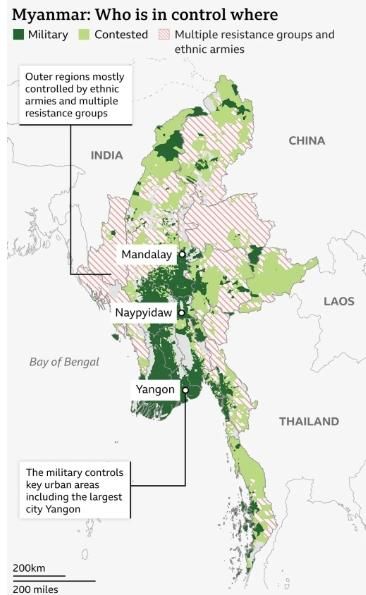
The military now
controls less than at any time since they first took control of the country in
1962. Coordinated operations between ethnic armies and civilian militia
groups have put the military on the back foot. After heavy territorial
losses earlier this year Commander-in-Chief Min Aung Hlaing made a rare
admission that his forces were under pressure.
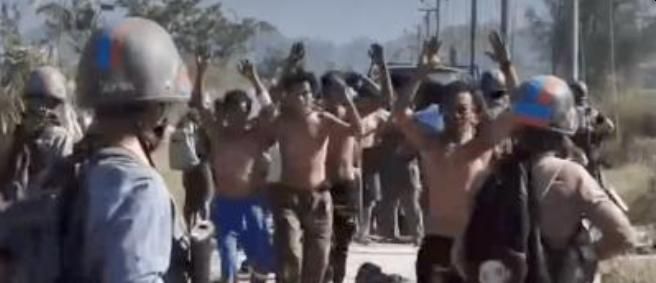
After heavy
territorial losses earlier this year Commander-in-Chief Min Aung Hlaing made a
rare admission that his forces were under pressure.
"Win Aung," a former intelligence officer,
is one agent managing the network of spies
The leaked Watermelon
intelligence from within the military is helping to tip the balance. Two years ago,
the resistance set up a specialized unit to manage the growing network of spies
and to recruit more. Agents like Win Aung [not his real name] collect the
Watermelon leaks, verify them where possible, and then pass them on to the
rebel leaders in the relevant area. He is a former intelligence officer
who defected to the resistance after the coup. He says they are now getting new
Watermelons every week and social media is a key recruitment tool. Their
spies, he says, range from low-ranking soldiers to high-ranking officers. They
also claim to have Watermelons in the military government - "from the
ministries down to village heads". They are put through a strict
verification process to ensure they are not double agents. Motivations for
becoming a spy vary. While in Kyaw's case, it was anger, for a man we are
calling "Moe" - a corporal in the navy - it was simply a desire to
survive for his young family. His wife, pregnant at the time, pushed him
to do so, convinced the military was losing and he would die in battle.

He began leaking
information to the Watermelon unit about weapons and troop movements. This kind
of intelligence is crucial. The ultimate goal of the resistance unit is to take
control of Yangon, Myanmar's biggest city and his former home. But they are a
long way off. The military retains the majority of major urban areas - home to
crucial infrastructure and revenue.

Unable to physically
penetrate the city, Daeva from his jungle base directs targeted attacks by
underground cells in Yangon using Watermelon intelligence.
Underneath a resistance leader plans attacks on
the military using Watermelon tip-offs

What is furthermore
of interest is that Indian insurgent groups that took refuge in Myanmar
and fought in its civil war have been streaming back across the border to
Manipur this year, security officers said, inflaming the 19-month ethnic
conflict there with weapons and battle-hardened cadres.

This has led to an
increase in violence between the Meitei community and the Kuki tribes. Since
May 2023, some 260 people have been killed in the fighting and more than 60,000
displaced.
Thus there is a
conflict that is spreading to new areas as insurgents from the rival groups
come across the border to Manipur.
Manipur, a hilly,
forested region of 32 lakh people, is bordered by Myanmar. The fighting there
was sparked last year by a court order that asked the state government to
consider checking with the Centre whether the Meiteis,
who mostly live in the Imphal Valley region, can be given the same government
benefits as those given to the Kukis, who live in the hills.
Ironically the Rohingya initially came to be lumped in with
Indian Muslims (specifically Chittagonians) in
Burmese and Rakhine nationalist rhetoric in the 1930s and 1940s and thus the
Muslim population came to be considered the colonizing other. This whereby
Buddhist Rakhines in the colonial
legislature in Rangoon post-1937 already began to differentiate themselves from
their Muslim neighbors, but it was really in the
Japanese invasion when the battle lines were drawn and the Muslims (who supported the British) and
the Buddhists (who supported the Bamars &
Japanese) separated into distinct communities.
The princely state of
Manipur, which now shares over 300-km-long
border with Myanmar, had trade and commerce with erstwhile Burma. A Meitei
king even married his daughter to a Burmese prince. The relationship soured after the Burmese invasion.
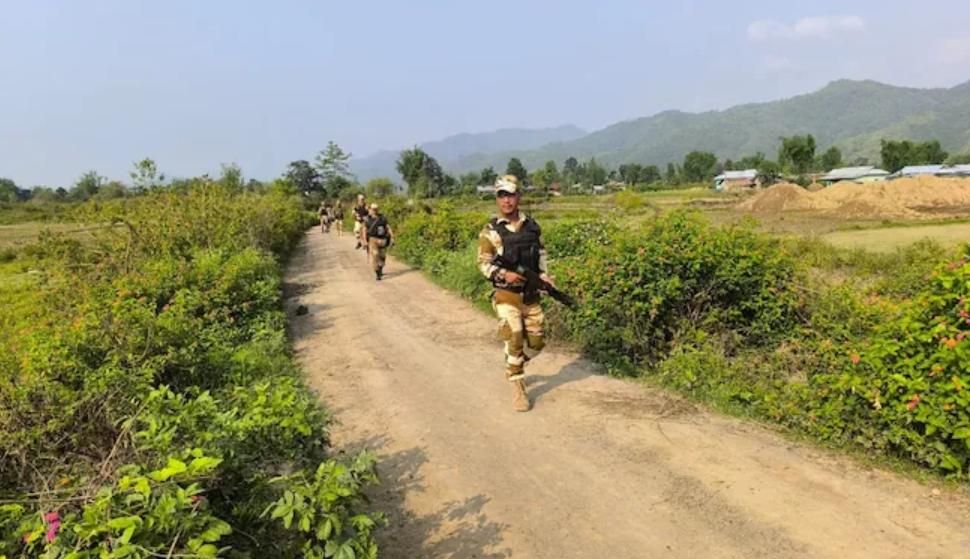
Indian militant
groups that took refuge in Myanmar and fought in its civil war have been
streaming back across the border to Manipur state this year, Indian security
officers said, inflaming the bitter 19-month ethnic conflict there with weapons
and battle-hardened cadres.
This has led to an
increase in violence between Manipur's dominant and mostly Hindu Meitei
community and the mainly Christian Kuki tribes - a conflict that critics say is
the biggest law-and-order failure of Prime Minister Narendra Modi's 11-year-old
government. Since May 2023, some 260 people have been killed in the fighting
and more than 60,000 displaced.
On Rival Sides
Security officers
said Meitei groups have been fighting on the side of the junta in Myanmar's
civil war and an estimated 2,000 of their cadres had been camping in Myanmar's Sagaing region, just across the border from Manipur, as of
December.
They have fought
anti-junta rebels like the People's Defence Force -
Kalay (PDF-K) and the Kuki National Army - Burma (KNA-B) in Sagaing,
Kachin and Chin areas of northern Myanmar, security officers and Kuki leaders
said.
An armed Kuki man stands at a checkpoint at Kangvai village in Churachandpur
district in the northeastern state of Manipur, India, July 23, 2023.
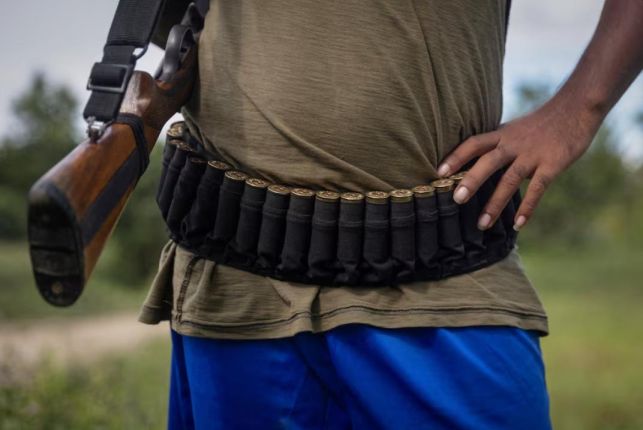
The Kukis, meanwhile,
have support from the Kachin rebels and have bought weapons from Myanmar's
semi-autonomous Wa state, according to three Indian
officers, several Kuki leaders and a PDF-K source in Myanmar.
Some Meitei groups
had operated from camps within Myanmar with the support of the military, but
were now scattered along the frontier and going back into Manipur, said Sui
Khar, vice chairman of the rebel Chin National Front, an anti-junta rebel
outfit that operates in Chin state.
The Indian military
and police officers said it was difficult to assess the number of insurgents
who have returned to Manipur.
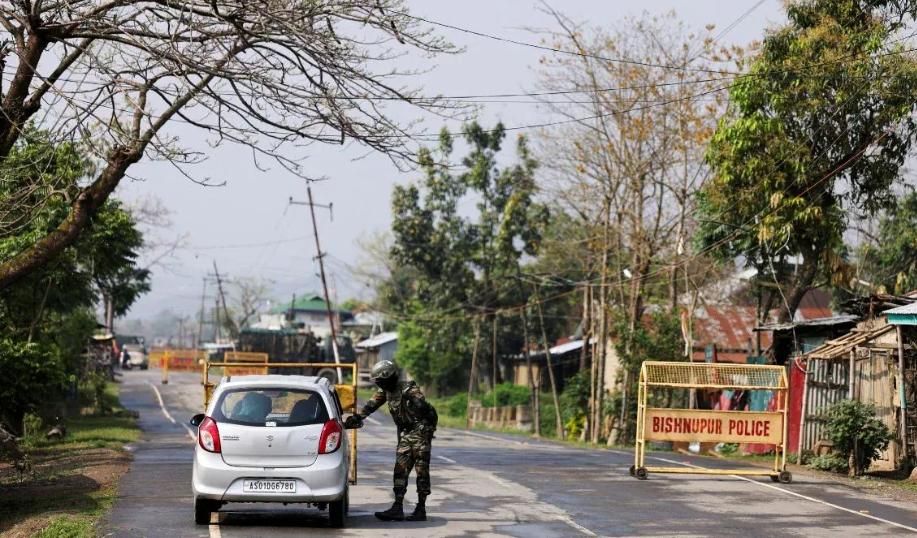
But more than 100
Meitei insurgents, including some intercepted by Indian authorities at the
Myanmar border, were arrested in Manipur last year and more than 200 this year.
People who fled
Myanmar carry their belongings across a bridge that connects Myanmar and India
at the border village of Zokhawthar, Champhai district, in India’s northeastern state of
Mizoram:
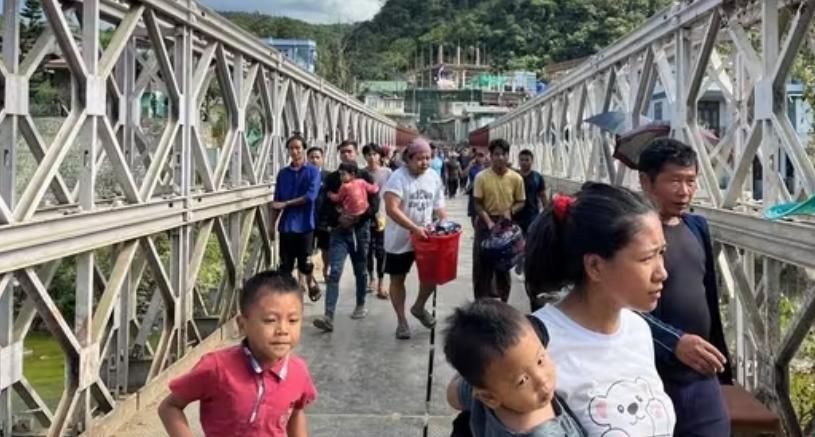
The Indian government
has announced plans to fence the entire 1,643 km long Indo-Myanmar border,
effectively ending the free movement regime between the two countries. The move
aims to enhance surveillance and curb insurgencies, smuggling, and the drug trade
in the region. The border currently has a free movement regime that allows
people on both sides to venture 16 km into each other's territory without any
documents. The decision to end the regime comes after an assessment by central
intelligence and security agencies. No deadline for completing the fencing has
been set yet.
For updates click hompage here